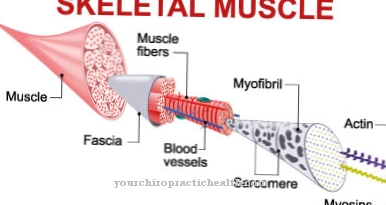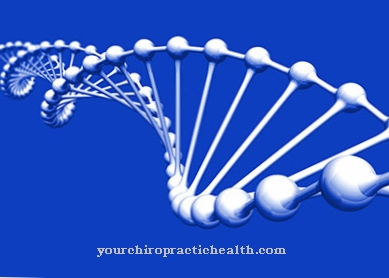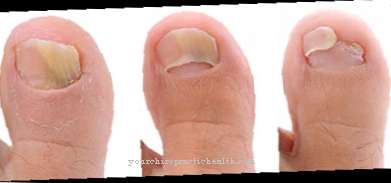A Astereognosia is the inability to recognize shapes by touching with eyes closed. The cause is damage to the central nervous system, where tactile impressions are processed and identified. In most cases, the cause of the astereognosia cannot be treated and, for this reason, can at best be alleviated through targeted tactile training.
What is astereognosia?

© marina_ua - stock.adobe.com
Humans are able to recognize things simply by touching them. Even with his eyes closed, the shape and consistency of the person being touched tells him enough about the property of the object. In addition to touch recognition, the sense of touch is also responsible for active touch exploration of things with closed eyes. In addition to the structures of the sense of touch, the associative centers and memory sections of the brain play a role in object recognition.
What has been touched is compared with previous touch experience and ideally recognized. The ability to recognize objects by means of active exploration is called stereognosy. If there is an inability to do this, it is called astereognosia. Patients with this symptom can no longer see things by touching them.
The terms tactile paralysis, tactile agnosia and stereoagnosia are used synonymously for the disease name. Astereognosia is one of the agnosias. As such, neuropsychological disorders after cerebral unilateral or bilateral cortical or subcortical lesions are known, which impair central sensory processing.
causes
The ability to recognize shape by touching is located in the primarily somatosensitive cortex of the brain. This is a defined portion of the cerebral cortex for the central processing of haptic perception. The incoming information comes from the receptors in the skin or the receptors inside the body. In the somatosensory cortex, in addition to touch, pressure sensations, vibrations and temperatures, pain sensations are sometimes also processed.
The somatosensory cortex is the end of the neolemniscus and is divided into primary-sensitive areas in the sense of Brodmann areas 1, 2 and 3. In addition, it contains the secondary-sensitive association areas in the sense of areas 40 and 43. The majority of the primary-sensitive cortex sits on the postcentral gyrus behind the central groove. The secondary part connects to the back and down. In most cases, astereognosia is caused by damage to the brain in the areas mentioned.
The symptom occurs particularly often after damage to the secondary associative areas. Such damage can be traumatic in origin, but it can also be caused by neurological diseases such as multiple sclerosis. Tumor diseases or strokes and degenerative changes are also possible causes of the lesions. Damage to the parietal association cortex in the non-language-dominant cerebral hemisphere after a stroke is sometimes the most common cause.
You can find your medication here
➔ Medicines for visual disturbances and eye complaintsSymptoms, ailments & signs
In patients with astereognosia, the receptors of the sense of touch definitely perceive primary sensory impressions. The sensation as the first step of perception is not disturbed. The only problem is the central processing of sensory impressions. The patient's sense of sight works perfectly in most cases. Therefore, despite the astereognosia, they can still name objects and shapes as long as they keep their eyes open.
But if you close your eyes and assign shapes by simply touching them, you are unable to do so. This central lesion symptom rarely occurs in isolation. In most cases, the symptom of astereognosia is associated with characteristic symptoms of the respective damage. Correspondingly, some of the patients also suffer from disturbances in the sense of vibration.
Others suffer from additional disorders of proprioception or general sensitivity to touch. Disturbances of thermoception or pain perception are just as often manifest. Exactly which symptoms occur in individual cases depends on the localization of the respective damage.
diagnosis
The diagnosis of astereognosia is mainly based on anamnesis or a tactile recognition test. Imaging of the brain allows a more detailed classification of the inability to recognize objects and enables localization to a specific brain area.
A differential diagnostic distinction between sensory disturbances and cognitive impairments of other kinds is necessary for diagnosis. The diagnosis of the causal brain lesion often takes place before the symptomatic diagnosis of astereognosia.
Complications
Astereognosia does not lead to any physical complications. However, it can severely limit the life of the person affected and usually cannot be treated. Most of those affected can recognize all other sensory impressions without problems or difficulties, but no forms can be recognized. Astereognosia can cause psychological problems and decreased self-esteem.
Children in particular can be disadvantaged if they are bullied at a young age due to astereognosia. Most people also experience disturbances in the sensations of heat and cold. Injuries can occur because extreme and dangerous situations cannot be properly assessed. Everyday life is also made more difficult by astereognosia, which can lead to severe orientation problems, especially for blind people.
Treatment is not possible. However, the skills can be trained and practiced, so that the astereognosia can be severely limited. This is especially the case if the astereognosia arose after a stroke. Although there are no complications, it cannot be predicted whether the astereognosia will completely decrease. If there is inflammation in the brain, surgical interventions can be carried out, which also lead to a positive course of the disease.
When should you go to the doctor?
The recognition of the structures of objects or surfaces without the involvement of the eyes requires that the primary stimuli of various tactile sensors in the skin as well as other haptic stimuli such as pressure and vibration sensations and pain stimuli are correctly recorded by the sensors and sent as impulses to brain areas of the somatosensory cortex . There the stimuli are combined in a complex processing process to form an overall impression that allows us to recognize the shape and nature of an object even without eye contact.
The characteristic of astereognosia is that the sensory stimuli are sent correctly to the brain, but the responsible centers are not able to process the incoming stimuli into an overall picture. Astereognosia is usually acquired through an accident with brain lesions, through a stroke or through tumors in the CNS due to space occupation.
If symptoms suggestive of astereognosia occur, it is important to seek medical advice from an experienced specialist to determine the extent of the brain malfunction. Based on the diagnosis, a training program can be developed that will help reduce the effects of the neurological deficits.
There is no drug or other therapy that could cure the disease. Interestingly, even with a completely intact sense of touch, the impression of form strictly follows the visual impression in the event of a conflict between the two impressions. For example, a straight bar appears to have a kink when viewed through a prism. The sense of touch also falsely reports this kink, an impression that disappears immediately when the eyes are closed.
Doctors & therapists in your area
Treatment & Therapy
In most cases, causal therapy is not available for astereognosia. For causal therapy, the respective cause would have to be eliminated. Most of the lesions of the central nervous system cannot be completely eliminated. Central nervous tissue is unable to fully regenerate. If, for example, encephalitis has caused the symptom of astereognosia, the inflammation can be reduced by administering cortisone, but scars remain in the inflamed area.
These scars continue to affect the ability in the long run. However, there is usually no longer a complete agnosia, but only a reduced processing ability of the affected areas. Even after strokes and traumatic brain injuries, scars and thus impairments remain. The situation is somewhat different with tumors.
In this case, the complete removal of the tumor can under certain circumstances serve as causal therapy and fully restore the ability of stereognosis. In all other cases, in addition to the therapy of the primary disease, training of tactile ability can at least improve an existing astereognosia. Ideally, after targeted training, neighboring cells of the brain take over the responsibilities of the defective brain cells.
Outlook & forecast
The prognosis for astereognosia is considered unfavorable under the current scientific conditions. The disease cannot be treated with current medical options. Symptom relief is also not possible. The disorder is caused by damage to the cortical area. If damaged, the tissue in the brain is considered irreparable.
Despite numerous efforts, scientists and researchers have not been able to cure defective brain tissue with drugs or surgery to date. An exchange of the brain comparable to an organ transplant is also excluded with the previous options. Although the efforts of the researchers continue, a patient with astereognosia cannot be given a positive prospect of recovery at this time.
An increase in the existing symptoms is also not to be expected. According to the findings and treatment reports to date, the brain damage is not spreading any further. The possibilities of self-help or alternative healing methods also do not lead to success in astereognosia.
The organism cannot heal itself for damage to the brain tissue on its own. In addition, the prerequisites for an alternative naturopathic treatment are not available. Therefore, the aim of treatment is to optimize the quality of life under the given conditions. It is helpful to make use of psychotherapeutic support.
You can find your medication here
➔ Medicines for visual disturbances and eye complaintsprevention
Astereognosia can only be prevented to the extent that causal strokes, encephalitis and degenerative processes within the brain can be prevented.
Aftercare
As a rule, there are no options for follow-up care available to the patient with astereognosia. However, these are also not necessary because the disease cannot be completely treated and does not always have to be treated. The life expectancy of the patient is not negatively influenced by the astereognosia.
However, the disease can negatively affect the life of the person affected and make it more difficult. The treatment is usually based on the exact causes of the astereognosia. In some cases it can be useful to take medication to alleviate the symptoms.
The patient is dependent on taking the medication regularly, and interactions with other medications should also be taken into account. If the astereognosia is caused by a tumor, it must be removed. An early removal of the tumor has a very positive effect on the further course of the disease and can prevent further complications.
An examination for other tumors is also useful. It is not uncommon for those affected by astereognosia to also suffer from psychological complaints. Contact with other people affected by the disease can have a positive effect on the further course of the disease, as it leads to an exchange of information.
You can do that yourself
The disorder usually cannot be treated. However, those affected can learn to cope better with their impairment and to cope with everyday life.
Unless vision is impaired and there are no other symptoms, adult patients usually have no problem coping with the challenges of everyday life. Most of the time, the social environment does not even notice the disorder.
But some people are inhibited because of their suffering. If these inhibitions impair quality of life, those affected should seek therapeutic help. If not only the sense of touch but also other sensory perceptions such as pain or temperature are disturbed, the risk of injuries and accidents in everyday life increases.
In particular, when astereognosia and its accompanying symptoms first appear in adulthood, those affected must learn to actively prevent accidents. Gas stoves are then safer than electric stoves because the flame can be seen while heat is not always felt.
There is also a risk of scalding when bathing or showering. That is why shower devices should be equipped with taps that allow a certain temperature to be preset. The bath water should always be measured as a precaution.
If only the sense of touch is restricted, it can be trained, especially if the astereognosis was caused by a stroke. Sufferers should get an exercise plan from a physical therapist who has experience with the disease. The sense of touch can at least partially be regained in this way.

.jpg)

























